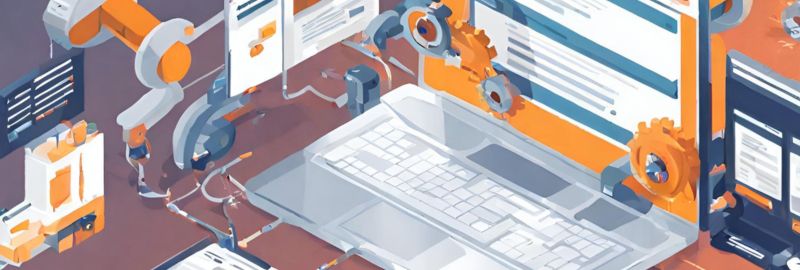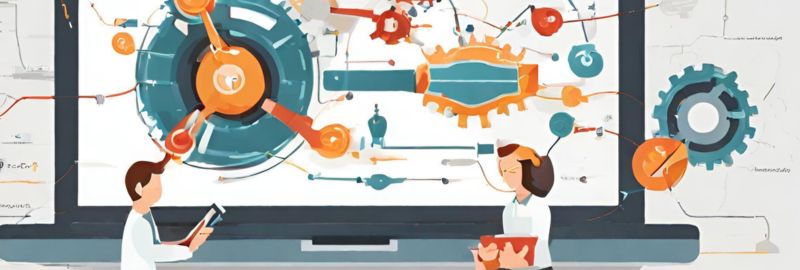Hyperautomation is one of the great technological opportunities, not just of the future, but of the present we are experiencing.
13 Nov 2023
Article Index
- What Is Hyperautomation?
- The VASS Approach
- The Hyperautomation Process Step by Step
- Defining the Target Operating Model
- Example: Automation of Financial Processes
- Example: Hyperautomation of Processes Banking
Hyperautomation is one of the great technological opportunities, not just of the future, but of the present we are experiencing. According to a Gartner report, the global market for this sector amounted to 596 billion dollars in 2022.
That same year, 90% of large-scale organizations globally had adopted some type of RPA (robotic process automation).
For the future, the outlook remains hopeful. According to that same report, the adoption of these technologies will lead to a 30% reduction in operating costs by 2024, thanks to the combination of hyperautomation with the redesign of existing operational processes.
For the next year, most organizations are expected to adopt at least three types out of the 20 different types of software that can be used to streamline and optimize processes.
Looking a bit more broadly, the numbers continue to grow. The compound annual growth rate (CAGR) forecasted for the RPA and hyperautomation sectors is 23.1%. This would mean an increase in the expected value, reaching 26 billion dollars by 2027.
What Is Hyperautomation?

Hyperautomation is a transformation process of all the processes of an organization, from strategy to technology and operations, with the goal of maximizing the operational efficiency of the company.
To drive digital transformation and create successful companies, it is necessary to modernize, optimize, and automate both operational processes and technologies. Thus, with the optimization of operational resources and processes and the creation of new digital experiences, digital growth is promoted.
Hyperautomation as we know it today was born in 2019, with the development of artificial intelligence. However, it is a global phenomenon that goes much further.
It is a holistic and global approach that uses the most cutting-edge automation technologies in all sectors, including RPA or robotic process automation, orchestration between different platforms and technologies through APIs, low code, process mining, machine learning, or even automatic and intelligent decision-making.
Many of these technologies are still in development, in their own continuous improvement process, which helps maximize the potential of hyperautomation. For next year, greater cognitive and physical integration is expected, leading in 2025 to the integration of workflows in Web3.
The VASS Approach

When facing a hyperautomation process, the first step is to perform a quick process assessment divided into several levels.
Firstly, simple automation of repetitive processes and operations and/or with little value is required. For this, cutting-edge technology is used thanks to partners such as Blueprism, Uipath, or Mulesoft, to maximize the value of the most immediate process automation.
Secondly, there is an automation of digital processes that can be divided into two parts. On one hand, data is automated with advanced processing tools, automation, and case management such as Appian, Mendix, or Opentext.
On the other hand, the collected data is analyzed and enriched using low code and process mining orchestration thanks to tools like SAP, Salesforce, or Celonis.
This entails an end-to-end process automation and control.
Automation is put at the service of artificial intelligence in the next step to have a cognitive workflow with continuously updated data that facilitates process leadership and the automatic making of intelligent decisions. In this field, VASAS partners are companies like Google, Microsoft, or AWS. The VASS ecosystem includes Intelygenz, a key company in the Artifical Intelligence-based ecosystem and leader in Big Data and Process Automation.
After these three steps, the organization will achieve hyperautomation.
The Hyperautomation Process Step by Step

To better understand this hyperautomation process, one must begin by understanding how digital process transformation should be approached. Thanks to a five-phase process: discovery, transformation plan, automation, measurement, and optimization, this transformation can be tackled.
In the first discovery phase, one must start with a comprehensive analysis, both qualitative and quantitative, of the current situation. This includes identifying any manual processes in place, as they will be the ones to be automated.
It’s also necessary to understand and create process models, as well as identify inefficiencies. Thanks to process mining, significant progress can be made in this initial phase by integrating them into automated systems that manage them in real-time.
Defining the Target Operating Model
In the second phase, a transformation plan must be prepared. To do this, one must define the Target Operating Model (TOM) and identify the processes that need to be automated. In this regard, it’s essential to identify improvements and prioritize the most important automations, establishing a scheduled implementation roadmap.
The third phase would be the automation process itself. This involves bringing the TOM to reality by implementing the necessary automations.
In the measurement phase, there are two key objectives. On one hand, verify the achievement of goals, and on the other, measure and monitor the KPIs of the automations.
To achieve this, firstly, operational KPIs must be defined, and secondly, they need to be implemented in Business Intelligence tools.
Finally, once everything is operational and under measurement, the time for optimization arrives, as this is a continuous and never-ending process.
For this, new optimization initiatives and actions to be taken are identified, after evaluating the results, defining new backlogs, and automating new processes.
Thanks to hyperautomation, organizations can enjoy key benefits such as:
- Reduction in execution errors.
- Reduction in SLA fulfilment time.
- Reduction in process execution cost.
- Increase in productivity.
- Increase in efficiency.
- Increase in end-user satisfaction.
Example: Automation of Financial Processes
One of our key success stories centered on the automation of financial processes at a satellite service provider. In this case, the objective was the creation of a robotic system to optimize repetitive functions.
Among others, the overdue payment notification process was fully automated, as well as the invoice upload process to Sharepoint, the supplier invoice download process, and even the travel invoice reconciliation process.
For this, UiPath was used, achieving a time-saving of 90% in basic processes. Additionally, a team was freed from repetitive, low-value workload, allowing them to focus on higher value-added tasks, significantly reducing costs.
In fact, the financial sector has significant opportunities for improvement thanks to hyperautomation. In the words of our consultant, Ignacio De Sopeña, Global Business Consulting Director at VASS, “all companies will have financial processes, and they can apply automation (or hyperautomation) to these or to any other type of process in the company. Optimization will enable significant synergies and savings by changing the methodology and capturing the value behind the process to generate greater value for the company.”
Example: Hyperautomation of Processes Banking
The Operations department of one of the top five financial brands needed to digitize its back-office processes in order to measure them and make them more efficient. After conducting a technological assessment, Appian was chosen as the tool to support them in this project.
Two types of processes were established. On one hand, there were simple processes with a very short time to market and over 1,000 operations to be digitized. Thanks to the process framework they developed, they were able to digitize simple operations within days (both linear processes and sequential tasks with various participant groups).
After its implementation in Spain, it has been extended to other regions of the organization: Portugal, USA, Mexico, Poland, and the United Kingdom.
On the other hand, there was a need to specifically create more complex processes that required more comprehensive work due to integrations, forms, field types, etc.
The result has been more than 1,500 processes that used to be done manually, now fully liberated. Among them, processes related to ICO loans, judicial orders, centralized admissions, or the Single Euro Payments Area.
These examples demonstrate how hyperautomation can become a significant ally in an organization’s day-to-day operations, reducing repetitive tasks, and even increasingly complex ones.
According to a Gartner report, the global market for this sector amounted to 596 billion dollars in 2022. That same year, 90% of large-scale organizations globally had adopted some type of RPA (robotic process automation).


 Facebook
Facebook
 X
X
 Linkedin
Linkedin